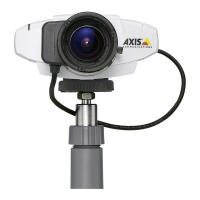AXIS 211W - System Options
32
Wireless Settings
These settings control how the camera interacts with the wireless network. Apart from identifying the wireless
network, it is also possible to enable wireless encryption.
SSID - This is the name of the wireless network the camera is configured for. The field accepts up to 32
alphanumeric characters. The name must be exactly the same as that used in the wireless access point or the
connection will not be established.
Leaving this field blank means the camera will attempt to access the nearest open network.
Note: SSID is sometimes written as ESSID.
Network type - Setting this to Master means the camera will attempt to access the nearest open access point. The Ad-hoc option
allows the camera to connect to other wireless devices (clients).
Note: WEP is the only available encryption method for Ad-hoc setting (see below).
Security - The AXIS 211W has three security options:
• WPA-/WPA2-PSK
• WPA-/WPA2-Enterprise
•WEP
WPA-/WPA2-Enterprise is more secure than WPA-/WPA2-PSK, which in turn is more secure than WEP. For
detailed instructions for setting up Wireless security in your AXIS 211W refer to the product’s Installation
Guide.
WPA-/WPA2-PSK (Wi-Fi Protected Access - Pre-Shared Key)
The AXIS 211W uses a pre-shared key (PSK) to initiate WPA security. The pre-shared key is entered on the
access point and on each device on the wireless network. The key can be entered either as Manual hex, as 64
hexadecimal (0-9, A-F) characters, or as a Passphrase, using 8 to 63 ASCII characters. The access point keeps out
unauthorized users by requiring the key to communicate.
WPA-/WPA2-Enterprise (Wi-Fi Protected Access - Enterprise)
WPA-/WPA2-Enterprise is a security method that provides strong data protection for multiple users and large
networks. It uses the 802.1X authentication framework with TKIP or AES encryption. Network users trying to
gain access are verified through an authentication server.
Certificates-The client and server authenticate each other using digital certificates provided by a Certificate
Authority. To gain access to the protected network, the AXIS 211W presents its certificate to the network switch.
If the certificate is approved, the switch allows access. You may need to contact your network administrator for
information on certificates, user IDs and passwords. For more information about certificates
For more information on certificates see page 28 and refer to the online help.
WEP (Wired Equivalent Protection)
The original security standard used in wireless networks that provides a minimal level of security that can deter
minor trespasses.
Note: Configuring the AXIS 211W using an unsecured wireless connection is not recommended, since passphrases and keys saved will be
sent in plain text. The fastest, most secure method to configure AXIS 211W is using a wired connection, since it disables the wireless
connection and ensures greater secrecy while entering settings.
SOCKS
SOCKS is a networking proxy protocol. The AXIS 211W can be configured to use a SOCKS server to reach
networks on the other side of a firewall/proxy server. This functionality is useful if the AXIS 211W is located on
a local network behind a firewall, but notifications, uploads, alarms, etc., need to be sent to a destination outside
the local network (e.g. to the Internet).

